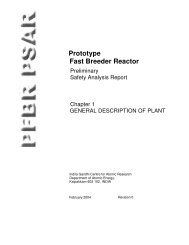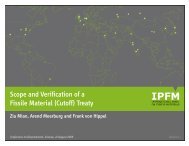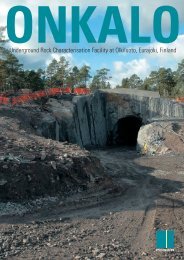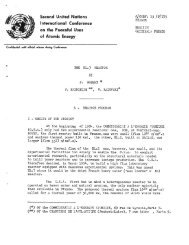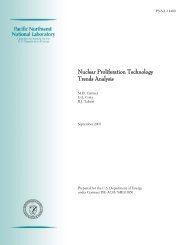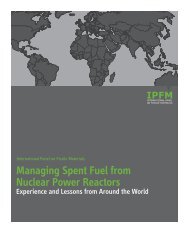Research Report No - International Panel on Fissile Materials
Research Report No - International Panel on Fissile Materials
Research Report No - International Panel on Fissile Materials
Create successful ePaper yourself
Turn your PDF publications into a flip-book with our unique Google optimized e-Paper software.
“It is easy to see that in certain circumstances aid given by the [<str<strong>on</strong>g>Internati<strong>on</strong>al</str<strong>on</strong>g> Atomic<br />
Energy] Agency with its full safeguards system in operati<strong>on</strong> could help in accelerating a<br />
military programme. Let us assume that the country receiving aid received from the<br />
Agency heavy water or fissile material for a reactor for peaceful purposes. If the country<br />
c<strong>on</strong>cerned already has heavy water or fissile material, the loan of the Agency's heavy<br />
water or fissile material to that extent liberates the country's own materials for use in<br />
military programmes.”<br />
Homi Bhabha, Founder of the Indian nuclear program, 1964. 1<br />
I. Introducti<strong>on</strong><br />
On July 18, 2005, U.S. President George Bush and Indian Prime Minister Manmohan<br />
Singh issued a joint statement in Washingt<strong>on</strong>, D.C. laying the grounds for the resumpti<strong>on</strong><br />
of U.S. and internati<strong>on</strong>al nuclear trade with India. 2 This trade has been suspended for<br />
about three decades because India is neither a signatory to the Nuclear <str<strong>on</strong>g>No</str<strong>on</strong>g>n-Proliferati<strong>on</strong><br />
Treaty (NPT) nor allows <str<strong>on</strong>g>Internati<strong>on</strong>al</str<strong>on</strong>g> Atomic Energy Agency (IAEA) safeguards <strong>on</strong> all<br />
its nuclear facilities. The July agreement has generated domestic political debate in the<br />
United States and India, and c<strong>on</strong>cern <strong>on</strong> the part of a number of other countries. 3 Am<strong>on</strong>g<br />
the issues is the fear that the agreement serves to normalize India’s status as a nuclear<br />
weap<strong>on</strong> state and so weakens the NPT and the larger n<strong>on</strong>proliferati<strong>on</strong> regime. Another<br />
important c<strong>on</strong>cern is that it may serve to expand India’s potential nuclear weap<strong>on</strong><br />
producti<strong>on</strong> capabilities, and thus hinder internati<strong>on</strong>al efforts to end the producti<strong>on</strong> of<br />
fissile materials for nuclear weap<strong>on</strong>s.<br />
As part of the July 2005 deal, the Bush Administrati<strong>on</strong> offered both to amend U.S. laws<br />
and policies <strong>on</strong> nuclear technology transfer and to seek the necessary exempti<strong>on</strong>s in the<br />
internati<strong>on</strong>al c<strong>on</strong>trols <strong>on</strong> the supply of nuclear fuel and technology managed by the<br />
Nuclear Suppliers Group (NSG) of states so as to allow nuclear trade with India. In<br />
exchange for the lifting of these restricti<strong>on</strong>s, India’s government offered to identify and<br />
separate civilian nuclear facilities and programs from its nuclear weap<strong>on</strong> complex, and<br />
volunteer these civilian facilities for IAEA safeguarding. However, the final shape and<br />
status of the deal is still unclear since it will require the U.S. C<strong>on</strong>gress to amend existing<br />
laws, and a c<strong>on</strong>sensus am<strong>on</strong>g the NSG countries, both of which may attach c<strong>on</strong>diti<strong>on</strong>s<br />
that India may not accept. 4<br />
At the March 2006 summit in New Delhi between President Bush and Prime Minister<br />
Singh, it was announced that the Bush Administrati<strong>on</strong> was satisfied with the proposed<br />
Indian plan to separate its program into a civilian and a military comp<strong>on</strong>ent. 5 The<br />
separati<strong>on</strong> plan offers to subject eight Indian power reactors that are either operating or<br />
under c<strong>on</strong>structi<strong>on</strong> to IAEA safeguards, in additi<strong>on</strong> to the six reactors that are already<br />
subject to safeguards because they were purchased from abroad [see Appendix 1 for a list<br />
of India’s operating and under c<strong>on</strong>structi<strong>on</strong> reactors]. These ‘civilian’ facilities will be<br />
put under safeguards “in a phased manner” by 2014 and thereafter will remain open to<br />
inspecti<strong>on</strong>s in perpetuity. India’s remaining eight power reactors, all its research reactors,<br />
and the plut<strong>on</strong>ium-fuelled fast breeder reactor program are to be part of the military<br />
5



